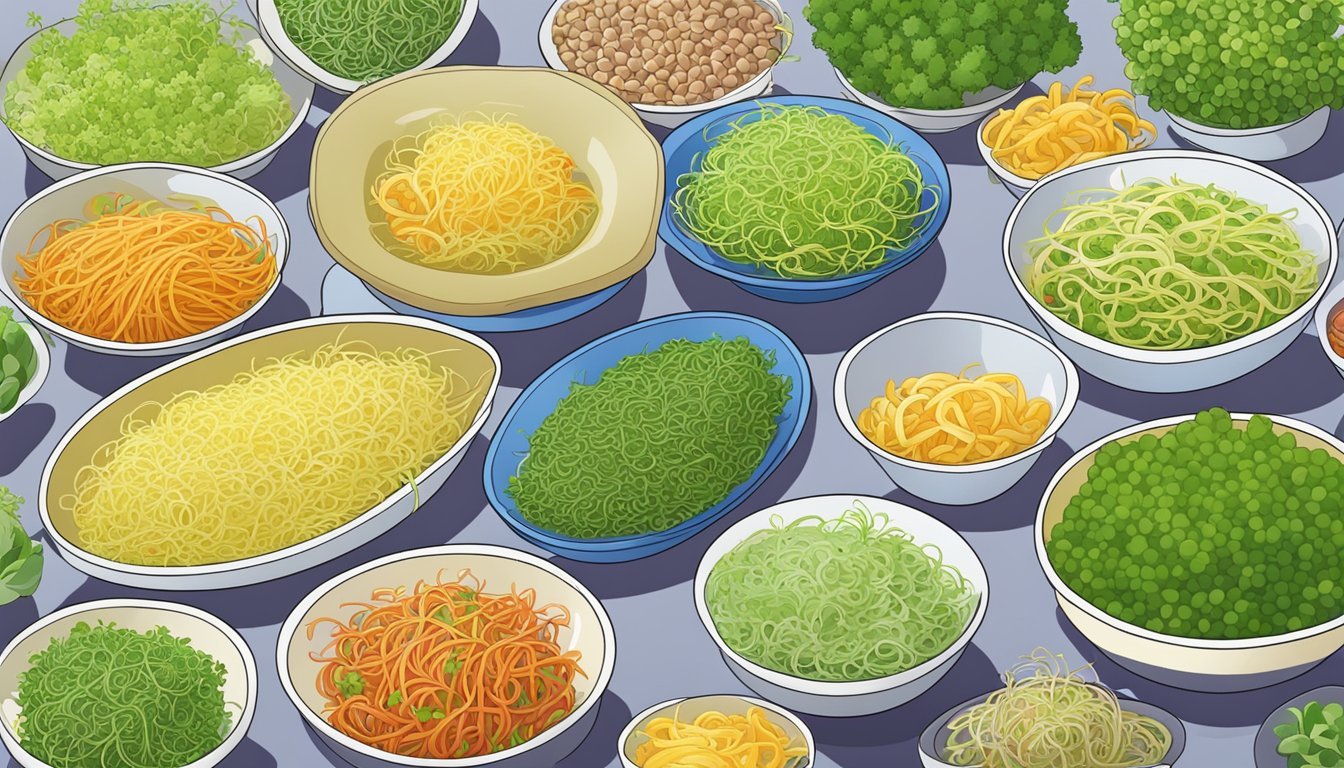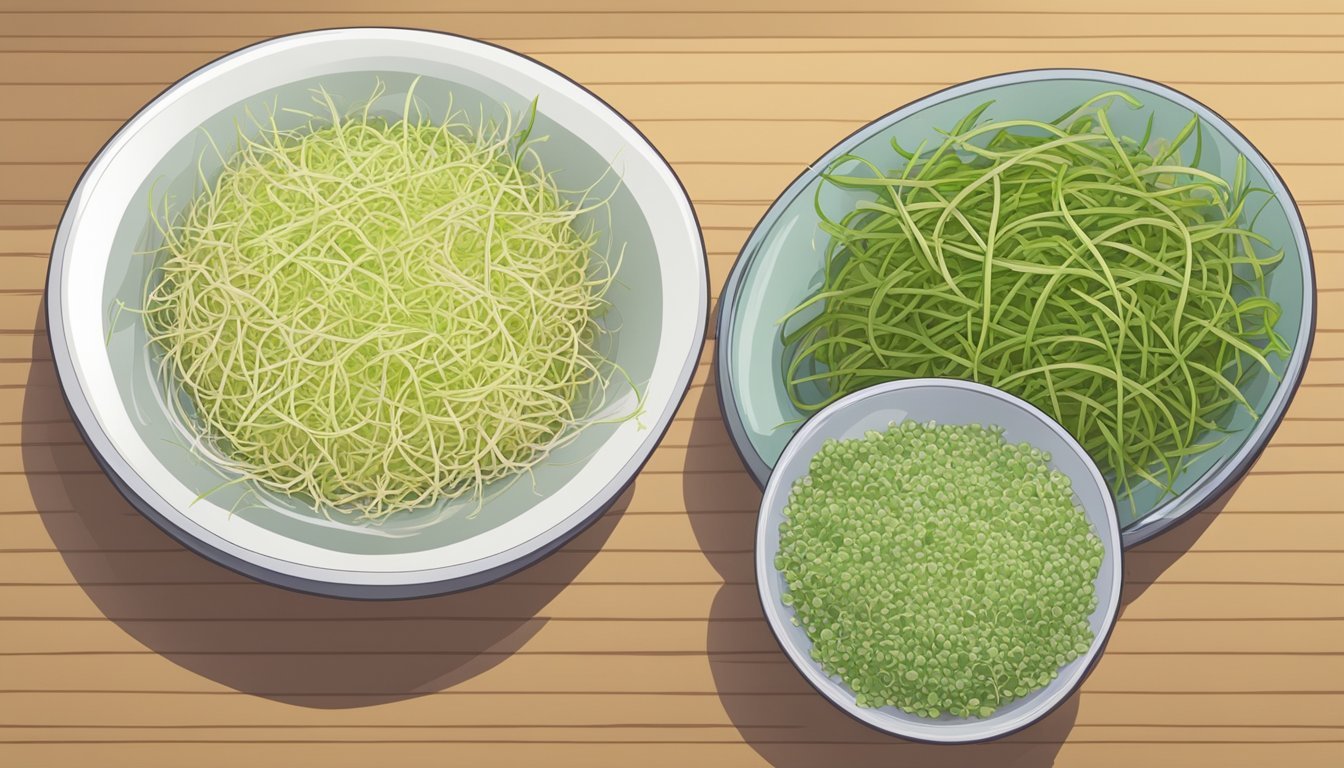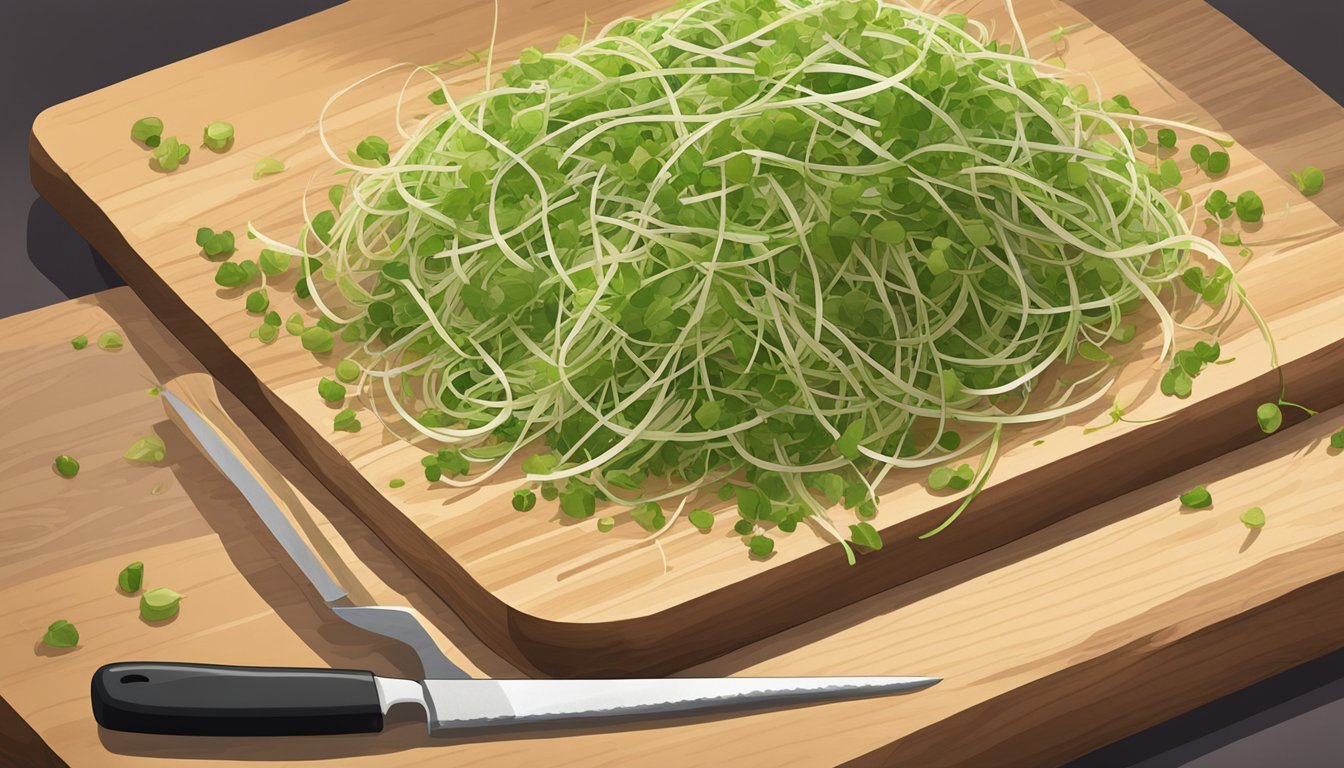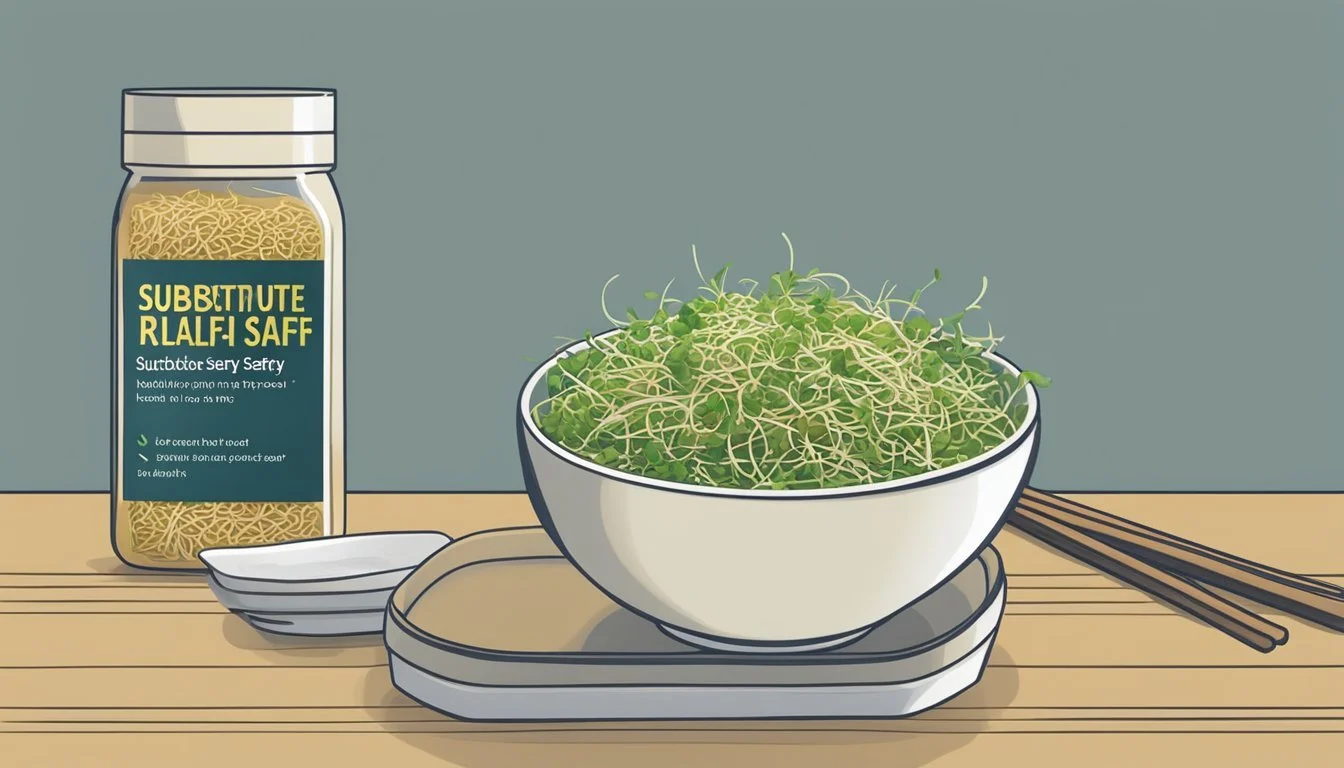How to Substitute Alfalfa Sprouts for Bean Sprouts
A Step-by-Step Guide
In the realm of culinary substitutes, alfalfa sprouts stand out as a versatile alternative to bean sprouts. Both alfalfa and bean sprouts provide a crunchy texture and are commonly used to enhance the freshness of various dishes, from salads to sandwiches (What wine goes well with sandwiches?). While bean sprouts, typically derived from mung beans, are a staple in Asian cooking known for their slightly nutty taste and substantial crunch, alfalfa sprouts are more delicate, with a milder flavor that can complement a wide range of recipes.
The process of substituting alfalfa sprouts for bean sprouts is straightforward, making it an accessible option for home cooks seeking to adapt a recipe. When bean sprouts are not available or if a lighter texture is preferred, alfalfa sprouts can be used as a replacement without compromising the integrity of the dish. They are particularly well-suited for cold dishes such as wraps or salads, where their subtle taste and slender shape blend seamlessly with other ingredients.
Understanding the differences between the two can enhance the cooking experience. Bean sprouts are larger and have a denser bite, which makes them ideal for stir-fries and noodle dishes that require the sprouts to withstand heat without losing their structure. In contrast, alfalfa sprouts are best added to dishes at the end of the cooking process or used raw to preserve their delicate nature and nutritional content. With thoughtful substitution, alfalfa sprouts can successfully be incorporated into an array of recipes, allowing chefs to maintain the desired texture and taste of their culinary creations.
Understanding Sprouts
In this section, the focus is on the distinct properties of bean and alfalfa sprouts, their nutritional profiles, and how they compare to one another.
Bean Sprouts Overview
Bean sprouts, commonly germinated from mung beans or soybeans, are a staple in many Asian cuisines. They are known for their crisp texture and mild flavor, often used in dishes like spring rolls, soups, and salads. Mung bean sprouts tend to be slightly chewy with a fresh taste, while soybean sprouts have a robust texture and can have a slightly bitter taste. Both versions are rich in nutrients, offering protein, fiber, vitamin C, and other vitamins and minerals such as potassium and calcium.
Alfalfa Sprouts Characteristics
Alfalfa sprouts are known for their delicate flavor and soft texture which provides a subtle crunch. They are typically smaller and thinner than bean sprouts and come from the alfalfa plant. These sprouts are also nutritious; they are a good source of antioxidants, vitamins, and minerals. Due to their more delicate nature, alfalfa sprouts have a shorter shelf life and should be consumed quickly after harvesting.
Nutritional Comparison
When comparing the nutritional content of bean and alfalfa sprouts, it is noticeable that both contain valuable nutrients. Generally, bean sprouts are more substantial in protein and fiber, making them a filling addition to meals. Alfalfa sprouts, while lower in calories, are particularly high in vitamin C and antioxidants.
Nutritional Content per 100g:
Nutrient Bean Sprouts Alfalfa Sprouts Calories 30 23 Protein 3g 4g Fiber 2g 1.9g Vitamin C 13.2mg 8.2mg Calcium 13mg 32mg Iron 0.91mg 0.96mg Potassium 149mg 79mg
While this table provides a snapshot, vitamin and mineral contents can vary based on sprout maturity and growing conditions. Bean sprouts tend to dominate in potassium and have a higher calorie count due to their denser nature, whereas alfalfa sprouts have a higher calcium content and slightly more iron. Both sprouts bring diversity in texture and nutrition to a diet.
Cooking and Preparation Tips
When substituting alfalfa sprouts for bean sprouts, it is important to consider the texture and flavor they bring to dishes. Alfalfa sprouts are more delicate and have a milder taste, which may affect the intended outcome of the salad or cooked dish.
Substituting in Salads
In salads, alfalfa sprouts can be used as a direct substitute for bean sprouts to add a crunchy and fresh element. However, one should note that alfalfa sprouts are less robust and may not provide the same level of crunch. To compensate, consider adding other crunchy vegetables as complements such as:
Shredded carrots: for sweetness and additional crunch.
Green cabbage or napa cabbage: finely sliced to bulk up the salad and mimic the texture of bean sprouts.
Sunflower seeds: for a nutty flavor and more texture.
Keep the sprouts raw to maintain their nutritional content and delicate nature.
Substituting in Cooked Dishes
For cooked dishes like stir-fries, pad thai, or Asian cuisine in general, alfalfa sprouts should be added at the very end of the cooking process to avoid over-wilting. Their delicate structure doesn't hold up to heat as well as bean sprouts, so they're best when just warmed through, retaining some of their crispness. When used in cooking, consider the following:
Add alfalfa sprouts after removing the dish from heat.
If the recipe calls for bean sprouts as a significant ingredient for texture, pair the alfalfa sprouts with firmer vegetables like shredded carrots or cabbage to maintain the dish's structural integrity.
For dishes like pad thai, the alfalfa sprouts can still provide a fresh contrast but remember they will not contribute as much body to the dish as bean sprouts would.
When using soybeans or other bean sprout substitutes in cooked applications, one must adjust cooking times due to their larger size and firmer texture compared to alfalfa sprouts.
Alfalfa Sprouts in Raw Dishes
Alfalfa sprouts, with their crisp texture and sweet flavor, are an excellent candidate for raw dishes. They are versatile in enhancing the freshness and nutritional value of sandwiches and wraps, as well as adding a crunchy element to soups and broths without requiring cooking.
Enhancing Sandwiches and Wraps
In sandwiches and wraps, alfalfa sprouts serve as a crunchy vegetable layer that elevates the sensory experience with minimal effort. They are especially effective when paired with soft ingredients like avocado or cream cheese, offering a contrast in textures. A classic combination might be sprouts with slices of cucumber, tomato, green onion, and bell peppers to achieve a medley of flavors and crunch. Here is a simple way to incorporate alfalfa sprouts into these meals:
For Sandwiches:
Layer alfalfa sprouts between slices of multigrain bread.
Include vegetables like tomatoes and cucumbers.
Add green onions or thinly sliced bell peppers for extra crunch.
For Wraps:
Spread a thin layer of hummus or cream cheese on a tortilla.
Top with a handful of alfalfa sprouts.
Roll with assorted veggies like sliced bell peppers and green onions.
Refreshing Soups and Broths
Although alfalfa sprouts are not commonly associated with soups and broths due to their raw nature, they can be a refreshing addition when used as a garnish. They impart a subtle sweetness and a delightful crunch to the dish. For those looking to mimic a texture similar to traditional bean sprouts, alternatives like bamboo shoots or enoki mushrooms that are often used in Asian cuisine, can be included in the soup just before serving to preserve their crunchy texture. Here's how sprouts can be introduced to soup:
Top Soups and Broths:
Sprinkle a generous amount of alfalfa sprouts on top of the soup just before serving.
Keep the sprouts raw to maintain their crispness.
Add sliced bamboo shoots or enoki mushrooms for a varied texture.
In conclusion, swapping bean sprouts for alfalfa sprouts in raw dishes invites a fresh perspective and can lead to savory combinations in sandwiches, wraps, and even soups.
Texture and Flavor Considerations
When using alfalfa sprouts as a substitute for bean sprouts, it's essential to consider the textural differences and the impact on the dish's flavor profile. Alfalfa sprouts offer a similar crisp texture and a mild flavor, making them a suitable alternative in various dishes.
Achieving the Right Crunch
Alfalfa sprouts provide a crisp texture that mimics that of mung bean sprouts, albeit slightly less crunchy. To replicate the crunchy texture more closely, one might:
Incorporate additional elements like bamboo shoots or sunflower sprouts that are known for their firmness.
Briefly sauté alfalfa sprouts to enhance their crispiness, keeping the cooking time short to preserve the texture.
Balancing Flavors
While mung bean sprouts have a nutty flavor, alfalfa sprouts are milder and can complement a wide range of dishes without overwhelming them. To balance the flavors:
Introduce additional flavor components if a stronger taste is desired, such as a small number of finely chopped bamboo shoots for their subtle earthiness.
For recipes where a nutty flavor is essential, consider a sprinkle of toasted seeds such as sesame to the dish after adding alfalfa sprouts.
Common Substitute Questions
In the quest for the perfect crunch and nutritional profile, many turn to alfalfa sprouts as a substitute for bean sprouts. This section addresses common queries regarding this substitution, focusing on how alfalfa sprouts compare with other sprouts, and essential tips for handling and storage.
Alfalfa Versus Other Sprouts
Alfalfa sprouts are a popular alternative to bean sprouts, known for their slightly nutty flavor and tender texture. While bean sprouts are harvested from mung beans, alfalfa sprouts come from the alfalfa plant, resulting in subtle taste differences. Alfalfa sprouts are less crunchy than bean sprouts but can be used interchangeably in most dishes.
Regarding other alternatives, pea sprouts share a similar size and appearance to alfalfa but have a more distinct pea-like taste. Sliced snow peas offer a crunchier texture, suitable for stir-fries and salads. Sunflower and soybean sprouts offer a more substantial bite and may possess a stronger, nuttier flavor profile compared to the delicate taste of alfalfa. One may also consider watercress or radishes for their distinctive flavors: watercress with a peppery note, and radishes with a spicy kick.
Handling and Storage FAQ
Proper handling and storage of alfalfa sprouts are paramount for maintaining their freshness and safety. It is recommended to rinse them thoroughly before use to remove any debris or bacteria. The ideal storage method for alfalfa sprouts is in a container in the refrigerator, where they can stay fresh for approximately five to seven days.
Refrigerated Storage Room Temperature Comment Five to seven days Not recommended Keep in sealed containers for freshness
To further extend their shelf-life, one might wrap the sprouts in a damp paper towel before placing them in a plastic bag or container. This provides the necessary moisture without excess water that can hasten spoilage.
In contrast, fresh bean sprouts tend to be more perishable, often requiring consumption within a couple of days when stored in the refrigerator. It’s best to use fresh bean sprouts immediately to enjoy their full crispness.
One should avoid freezing alfalfa sprouts, as they can become limp and lose their desirable texture. Similarly, other delicate sprouts like celery or soybean should also be consumed while fresh to best appreciate their textural qualities.
Alternative Substitutions
While Alfalfa sprouts are a popular replacement for bean sprouts, other vegetables and varieties of sprouts can similarly enhance meals with their texture and nutritional value. Whether for raw salads or stir-fry dishes, there are many other suitable options.
Other Vegetables as Substitutes
Several vegetables can stand in for bean sprouts with their distinct textures and flavors. Cabbage, when shredded, can serve as a bulky, tender addition to dishes requiring volume, while bok choy contributes a slight peppery taste, perfect for garnishes or stir-fries. Snow peas offer a crunchy texture, making them an appropriate substitute for bean sprouts in many dishes. Sliced thinly, they can mimic the crisp aspect of sprouts. Carrots, when shredded, can add a hint of sweetness and an appealing color. For those who enjoy a unique and earthy flavor, enoki, an edible mushroom, serves as a delightful alternative, especially in soups and salads.
Vegetable Characteristics Best Used in Cabbage Bulky and tender, adds volume Salads, Spring Rolls Bok Choy Peppery taste, good for garnishes Stir-fries, Soups Snow Peas Crunchy texture, fresh flavor Stir-fries, Salads Carrots Sweetness, adds color Salads, Spring Rolls Enoki Earthy flavor, unique texture Soups, Salads
Sprouts Beyond Alfalfa and Bean
When it comes to sprouts specifically, there are several nutritious options beyond Alfalfa and bean sprouts. Sunflower sprouts bring a hearty, nutty flavor that can enrich a variety of recipes. Sprouts from other legumes like soybeans can also be used for their crunchy texture and health benefits. Bamboo shoots, although not sprouts, have a comparable crispness and are fitting for Asian-inspired stir-fry dishes. These alternatives not only offer versatility in cooking but also provide an array of vitamins and minerals beneficial for a healthy diet.
Sunflower sprouts: hearty, nutty flavor – ideal for salads and sandwiches.
Soybean sprouts: a legume variety with a crunchy texture – suitable for Korean dishes like bibimbap.
Bamboo shoots: adds a distinctive crispness – best for Asian stir-fries and soups.
Health and Safety Tips
When substituting alfalfa sprouts for bean sprouts, one should consider their health and safety. Both types of sprouts are germinated seeds and while they are healthful, offering fiber and vitamins like Vitamin A, there are specific precautions to ensure safety.
Firstly, it is essential to purchase fresh sprouts from reputable sources. They should have a clean appearance, free of sliminess or unpleasant odor. The alfalfa sprouts should be stored in the refrigerator and consumed within 3 to 5 days to avoid spoilage.
When preparing alfalfa sprouts, rinse them thoroughly under cold water to remove any potential bacteria. This step is crucial as sprouts are often eaten raw and germinated in warm conditions favorable to bacterial growth.
At times, individuals may find bean sprouts to have a chewier and thicker texture compared to the more delicate alfalfa sprouts. These textural differences do not affect the safety but may affect culinary preferences.
Some may perceive a bitter taste in older sprouts, which is an indicator that they shouldn't be consumed. Fresh alfalfa sprouts should have a mild, slightly nutty flavor.
Lastly, for individuals with compromised immune systems, it is advised to cook sprouts to reduce the risk of foodborne illness.
Sprout Type Shelf Life Preferred Appearance Taste Profile Alfalfa 3-5 days Clean, crisp Mild, nutty Bean Longer Crunchy, firm Neutral, fresh
Adhering to these tips will ensure a safe and enjoyable consumption experience when using alfalfa sprouts as a substitute for bean sprouts.







